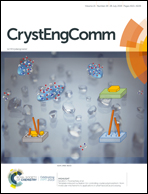Bi4O5I2 flower/Bi2S3 nanorod heterojunctions for significantly enhanced photocatalytic performance†
Abstract
Optimally engineered heterojunctions are of great interest to pursue higher photocatalytic activity in a wide range of applications. A series of controlled Bi4O5I2/Bi2S3 heterojunctions have been fabricated through a solvothermal method combined with an anion exchange process. The in situ growth of Bi2S3 nanorods from Bi4O5I2 flowers reveals that there exist strong coupling and intimate interfaces between the two semiconductors. The Bi4O5I2/Bi2S3 heterojunctions exhibit excellent photocatalytic activities and stability in the photocatalytic reduction of Cr(VI) under visible light irradiation (λ > 420 nm). The highest apparent rate constant is up to 0.05614 min−1, which is about 56 and 7.5 times that of pristine Bi4O5I2 and Bi2S3, respectively. Further detailed characterization reveals that the drastically enhanced and stable Cr(VI) reduction can be attributed to the efficient transfer and spatial separation of the photo-induced carriers, resulting in strong light harvesting. It results from not only the synergetic effects of Bi2S3 sensitization and heterojunctions with matched band structures, but also the unique flower/nanorod architecture and intimate contact at the molecular scale between Bi4O5I2 and Bi2S3. It also provides critical insights into the underlying pathways involved in the photocatalytic reduction of Cr(VI) over Bi-based heterojunctions.



 Please wait while we load your content...
Please wait while we load your content...